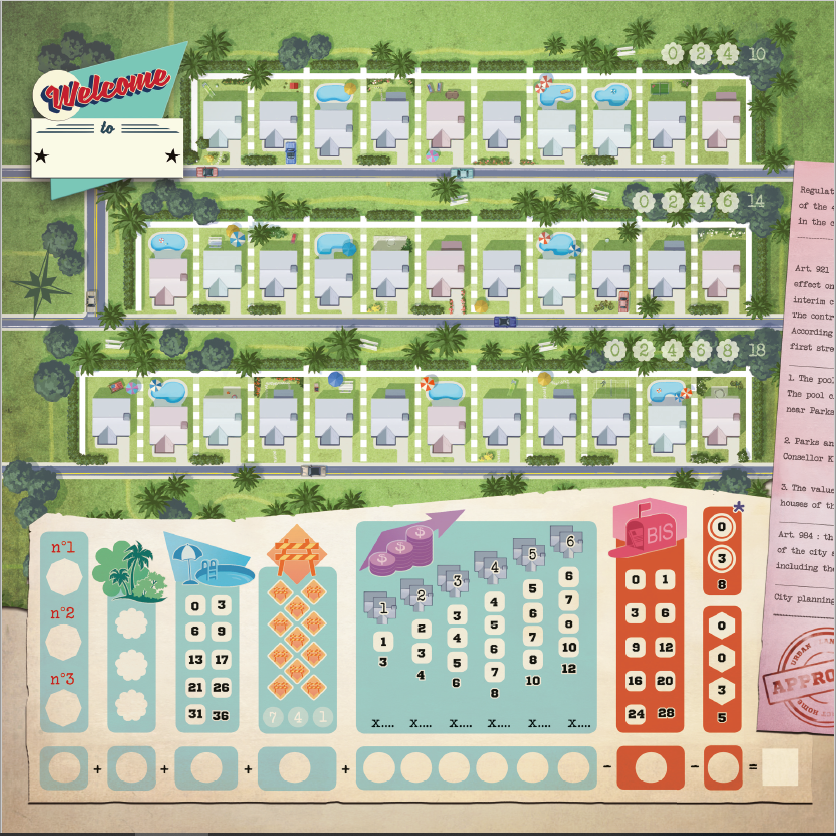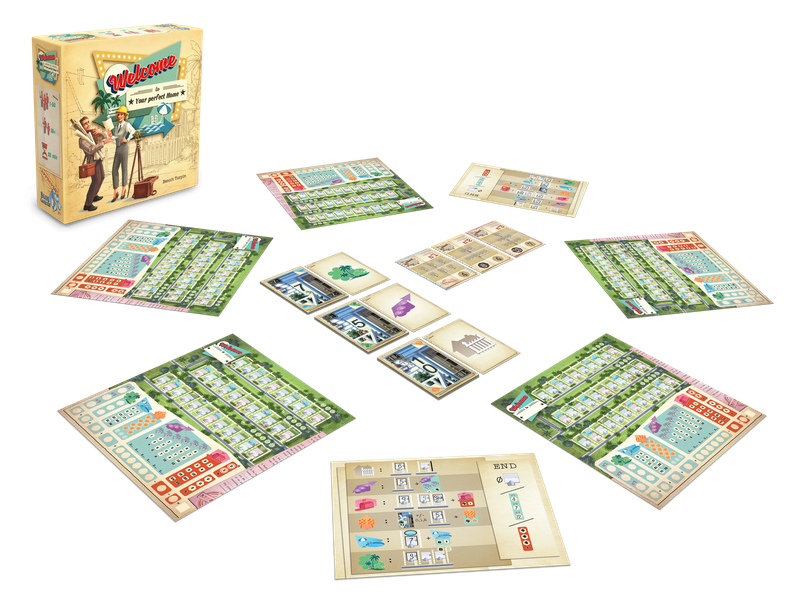Welcome To… (Boardgame)
 Fill in your suburb wisely (in numerical order) to score points in this (sort of) Roll and Write style game of designing neighborhoods. Cards are flipped up from a deck and players must choose which cards to use and for what purpose as they fill in the blanks on their personal score sheet.
Fill in your suburb wisely (in numerical order) to score points in this (sort of) Roll and Write style game of designing neighborhoods. Cards are flipped up from a deck and players must choose which cards to use and for what purpose as they fill in the blanks on their personal score sheet.
Welcome To…
Designer: Benoit Turpin
Publisher: Deep Water Games
Players:1-100
Ages: 10+
Time: 25 min
(review copy provided by publisher)
Roll and Write games have swamped the boardgame world in the past few years. Welcome To… is not a roll and write game, although it has a bit of that style of feel. Players strive to fill in a neighborhood of houses by writing numbers in numerical order, but can score bonus points for improvements like adding in parks and pools or other types of improvements. Rather than relying on the roll of the dice, Welcome To… uses a deck of cards which eliminates the chances of extreme swings that can be generated by rolling dice.
To begin, players are given their own sheet of paper which serves as their playing area as well as their score sheet. The sheet is comprised of three rows of houses, with various bonus scoring options at the bottom. On a turn, players use one of the three stacks of construction cards to fill in spaces on their player sheet. The constructions cards have numbers ranging from 1 to 15 on one side, and a special effect on the other. The cards are flipped at the end of each turn so that there is always three numbered cards next to three special effects. Players select one of the number/effect pairs to use every turn.

Players first choose a number and write it on one of the houses on their scoresheet. However, numbers must be recorded such that they are in ascending order from left to right. Gaps can be left between numbers (to perhaps be filled in later), but the same number can’t occur twice in a row. Next, a player uses the special effect listed next to the chosen number.
- The Surveyor allows players to place fences between houses, forming groups in a row called Housing Estates of 1 to 6 houses which score points at the end of the game.
- The Real Estate Agent is used to upgrade the scoring for a specific sized housing estate. For example, it might increase the scoring value of all estates of exactly 3 houses.
- The Landscaper lets players cross off a “park” on the end of one of their three rows of houses, although it has to be the same row that was used to enter the house number. Parks scale up in scoring so that three on the end of a row are much more valuable than one .
- The Pool Manufacturer allows players to also build the pool (if there is one) associated with the house that was built this turn. Players score points at the end of the game for the total number of pools built.
- The Temp Agency allows player to adjust the associated housing number by one or two before writing it onto one’s sheet.
- The <<Bis>> allows players to duplicate a house number on their row. The duplicated house needs to be adjacent and can’t be separated by a fence. This comes at a small point penalty, which increases as more houses are duplicated.
- One final option, available anytime before or after building, allows players to create a Roundabout. This overwrites a house, creates a fence of both sides, and essentially breaks the row into two, allowing the housing numbers to start over at one on the right hand side. This can be done twice during the game, and costs a few points.

The final source of points are the City Planning cards (used if players want to play the “Advanced Variant.” At the start of each game, three plans are chosen. They require players to construct their neighborhood in specific ways. The first player to meet the criteria scores bonus points, with players who accomplish it later scoring a smaller amount.
If a player finds that they cannot legally play a housing number, they must cross off a Building Permit Refusal box, which can cost points at the end of the game. The end of the game is triggered when any player crosses off their third Building Permit Refusal, one player achieves all three city plans, or a player has managed to build all their houses. Scores are tabulated, including the many bonus scoring (and penalty) methods. Ties go to the player with the most completed Estates.
To give players more control over their actions, there is an option for Expert Rules. Here, players are dealt three cards and choose any two of them for their number and effect (they can’t be the same card.) The third card is then passed to the right, players are given two new cards (for a total of three cards), and may again use any two for their next turn.
Those looking for additional options should be aware there’s a special “solo mode” expansion with a sort of programmed AI as well as a number of “refill packs” of player sheets available as expansions. Each expansion reflects a specific theme such as Summer or Halloween. They all include a new scoring mechanic, such as driving an ice cream truck or collecting candy and ghosts. Most of them also have three new city plan cards to go along with the new effects.
Verdict:
Gamers will quickly compare this to the many roll and write games on the market. There is a very similar feel, but the cards provide both a much larger range of options (1-15) but also prevent large swings in probability (such as rolling several “2”s in a row, etc..) The distribution of cards is known, so players can usually expect to see a number they want if they’re willing to wait for it. I like how the number cards also have a symbol in the corner that says what special effect is located on the back. This means players know which three special effects will be available in the next round (although they won’t know the number.) This provides yet another way Welcome To… provides players with more opportunities for forward-planning. Something that can be frustrating in other roll and write games. Another selling point for the game is its ability to be played by almost any number of people. (At its GenCon launch they had reserved an entire room for the game, with space for well over 100 people to play all at once – using a projector for the cards, of course…) Finally, I appreciate the many ways to score. It allows players to pursue multiple possible paths to score. One can go for specific size estates and push to upgrade their scoring, go after row bonuses (like parks and pools), all while keeping an eye on opportunities to score the city planning cards. Taken as a whole, Welcome To… is a nice entry in the “roll & write”-ish genre. With its simultaneous gameplay, it can be played almost any number of players, giving it a semi-unique status. While the polish on roll & write style games is beginning to fade for me, Welcome To…, with its multiple valid paths for scoring and its opportunities for planning, remains solidly on the “I Like it” scale.
Kid Factor
While the scoring bonuses and strategy may be on the slightly complex side, there is no reading to be done. The rules are not hard to follow, so the game should be just fine for family gaming, even with the younger set.





Discussion Area - Leave a Comment